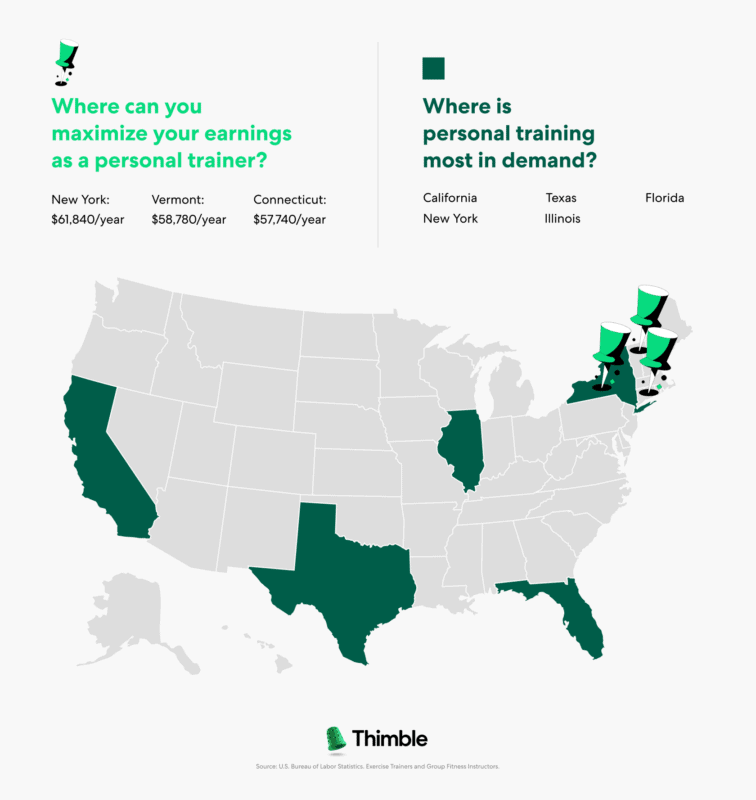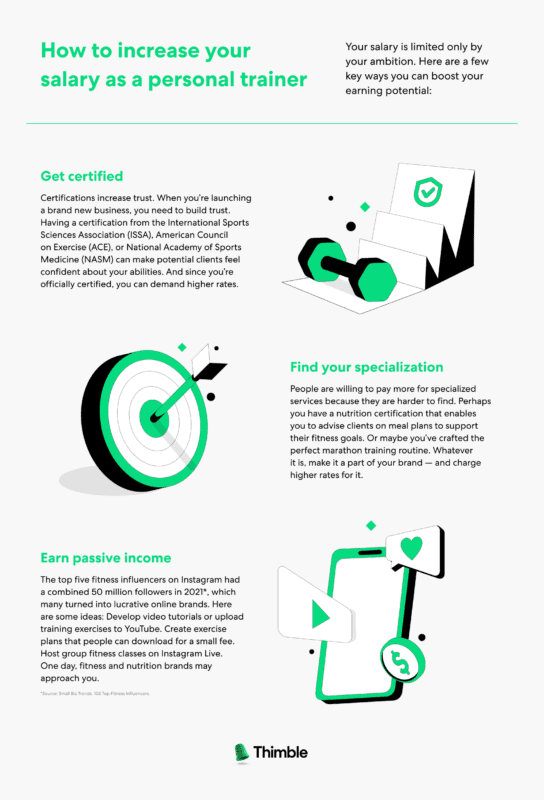Is it time to flex your love for working out into a full-time business? Before you hit the ground running, you should know the average personal trainer salary. According to Thimble’s survey of 1,000 small business owners, most trainers paid themselves a salary of up to $25,000 in 2021. Nationally, fitness pros made even more— between $23,000 and $76,000 for the year.1
The latest U.S. Bureau of Labor Statistics (BLS) data shows that the lowest average personal trainer salary is $22,960, the median average salary is $40,700, and the highest average salary is $75,940.

We crunch the numbers on a certified personal trainer’s salary and share tips for bulking up your income.
How much do personal trainers make per day?
According to the Bureau of Labor Statistics (BLS), there were 309,800 personal trainers in the United States in 2020.2 The median pay for the job was $19.48 per hour, which translates to $40,510 per year. The top 10% of trainers earned more than $76,550 — that’s 13% more than the U.S. median salary.3,4
The job outlook for personal trainers is making impressive gains. The BLS predicts that the personal training industry will grow 39% over the next decade, which is nearly four times faster than the average occupation.5 That means that personal trainers are in high demand. If you’re ready to start your career as a personal trainer, there are plenty of potential clients out there!
Where do personal trainers make the most money?
Where can you maximize your earnings as a personal trainer?

The three states with the highest average salaries are:6
- New York: $61,840 per year
- Vermont: $58,780 per year
- Connecticut: $57,740 per year
Where is personal training most in demand? Well, the states below have the highest number of personal trainers:7
- California
- Texas
- Florida
- New York
- Illinois
However, the following states have the highest concentration of personal training jobs, which can boost earning power:8
- Montana
- Colorado
- Rhode Island
- Kansas
- Washington
How much revenue can personal trainers make?
Depending on their earnings and expenses, personal trainers can expect to make up to $50,000 in revenue in 2022, according to our survey.
Roughly half told us they expect their revenue to stay the same in 2022, while the other 50% expect it to increase by 25% or more. All said that their earning power has increased significantly since starting their personal training business, and they are optimistic about their business success in 2022. For the industry as a whole, revenue increased 2.2% in 2021 alone.9
What do personal trainers do?
Personal trainers provide fitness training to clients on a private or semi-private basis, although they may also offer group classes. Clients approach personal trainers with a number of goals. They may be training for a triathlon, starting to lose weight or getting in better shape, or easing back into exercise after an injury. First, personal trainers work to understand a client’s goals. Then, they develop personal training plans for them, walk them through exercises and provide encouragement and education along the way.
Many personal trainers opt to go into business for themselves because they have a passion for helping people improve their health, as one personal trainer told us. They also love being able to set their own schedules, create customized fitness plans for their clients, and stay on top of the latest innovations in training and nutrition.
How to increase your salary as a personal trainer
As a personal trainer, your salary is limited only by your ambition. Here are a few key ways you can boost your earning potential:
Get certified
First things first: you are not legally required to get certified before you can start a personal training business. However, getting certified can be a great idea. Here’s why.
Certifications increase trust. When you’re launching a brand new business, you need to build trust. Having a certification from the International Sports Sciences Association (ISSA), American Council on Exercise (ACE), or National Academy of Sports Medicine (NASM) can make potential clients feel confident about your abilities. And since you’re officially certified, you can demand higher rates.
Find your specialization
Just as you can increase your rates by working in higher-paying locations, you can also increase your rates by working with higher-paying clients. People are willing to pay more for specialized services because they are harder to find.
What unique skills do you have that make you stand out as a personal trainer? Perhaps you have a nutrition certification that enables you to advise clients on meal plans to support their fitness goals. Or maybe you’ve crafted the perfect marathon training routine. Whatever it is, make it a part of your brand — and charge higher rates for it.
Earn passive income
Savvy personal trainers increase their earnings through passive income, like online videos and branding partnerships. For example, the top five fitness influencers on Instagram had a combined 50 million followers in 2021, which many turned into lucrative online brands.10
Here are some ideas: Develop video tutorials or upload training exercises to YouTube. Create exercise plans that people can download for a small fee. Host group fitness classes on Instagram Live. Build your following on social media, and one day, you may have fitness and nutrition brands approach you.

How much does it cost to run a personal training business?
Running a personal training business is not without costs, but it can be affordable if you plan well and follow a budget. Here are some of the things you can expect to include in your operating costs and expenses:
- Gym and equipment fees: Whether you train clients online or in-person, at their homes or at the gym, you will likely need to pay for some sort of gym membership or rental space. You may also choose to maintain your own equipment.
- Marketing: With time, your clients will refer you to their friends and family. But you can’t rely solely on word of mouth. Set aside money to pay for a website, social media ads, and other promotional materials.
- Taxes: When you work for yourself, it’s all too easy to forget that you have to deduct your own taxes. Consult a CPA to understand your expected costs.
- Business insurance: Whether you plan on being a lone wolf or building a pack of personal trainers, you need business insurance. Protecting yourself with an insurance policy is a good idea even if you do some personal training work for a gym or fitness studio, as you don’t know how much coverage their policy extends to you.
Stretch, flex, and train your way to a top personal trainer salary
As a personal trainer, you get paid to make other people’s lives better. It’s a rewarding gig, and a lucrative one if you work for it. You can pump up your rate by getting certified, finding a niche, and creating passive income streams through social media and video tutorials.
But none of this will matter if you don’t protect yourself with Personal Trainer Insurance. When all it takes is a single liability claim to jeopardize your business’s success, investing in the right insurance is the smart way to strengthen your bank account!
We’re rooting for your success as a personal trainer. Now go keep the world, yourself, and your business healthy!
Sources:
- U.S. Bureau of Labor Statistics. Exercise Trainers and Group Fitness Instructors.
- U.S. Bureau of Labor Statistics. Fitness Trainers and Instructors.
- U.S. Bureau of Labor Statistics. Fitness Trainers and Instructors.
- Census.gov. Income and Poverty in the United States: 2020.
- U.S. Bureau of Labor Statistics. Fitness Trainers and Instructors.
- U.S. Bureau of Labor Statistics. Exercise Trainers and Group Fitness Instructors.
- U.S. Bureau of Labor Statistics. Exercise Trainers and Group Fitness Instructors.
- U.S. Bureau of Labor Statistics. Exercise Trainers and Group Fitness Instructors.
- IBISWorld. Personal Trainers Industry in the US – Market Research Report.
- Small Biz Trends. 102 Top Fitness Influencers.








